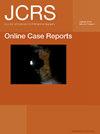Bilateral spontaneous Descemet membrane detachment after uneventful immediate sequential bilateral cataract surgery
Q4 Medicine
引用次数: 0
Abstract
Introduction: Immediate sequential bilateral cataract surgery (ISBCS) is a practice on the rise. To the authors' knowledge, this is the first reported case of bilateral Descemet membrane detachment (DMD) after uneventful same-day ISBCS, with emphasis on diagnosis and management. Patient and Clinical Findings: The case of a 66-year-old diabetic woman with chronic obstructive pulmonary disease and obstructive sleep apnea on home oxygen who developed spontaneous bilateral DMD after uneventful ISBCS for visually significant cataracts is presented. Although spontaneous DMD after uneventful phacoemulsification has been reported before, it has not been reported after same-day ISBCS to the authors' knowledge. The success rates with air pneumatic descemetopexy are excellent, with ranges between 90% and 95%. In this case, surgical intervention with gas injection in the anterior chamber and surgical peripheral iridotomies resulted in excellent visual acuity restoration in the patient. Diagnosis, Intervention, and Outcomes: Patient underwent same-day ISBCS under local anesthesia by different surgeons in either eye. Standard phacoemulsification techniques were used, and no intraoperative complications were noted. The patient returned with bilateral counting fingers vision 4 weeks postoperatively and reported her vision never improved after her cataract extraction. Anterior segment optical coherence tomography (AS-OCT) confirmed the presence of bilateral DMDs. Because of the patient's severely impaired vision, bilateral air descemetopexies were performed with clinical resolution of the DMD and excellent restoration of vision in both eyes. Conclusions: Sufficient evidence supports that performing ISBCS using internationally agreed protocols minimizes the risk of experiencing bilateral complications to a negligible level when compared with staged surgery. However, with ISBCS being on the rise, spontaneous bilateral DMDs may also be seen increasingly in those eyes with no underlying commonly recognized risk factors for spontaneous DMD. With unilateral DMD, watch and wait is a viable option. However, in bilateral DMD cases, earlier air or gas descemetopexy may be preferable to increase the likelihood of success and reduce the patient's period of decreased vision.双侧白内障即刻连续手术后的双侧自发性脱斯囊膜脱离
导言:双侧白内障即刻序贯手术(ISBCS)正在兴起。据作者所知,这是首例在当天顺利完成 ISBCS 后发生双侧戴斯麦膜脱离 (DMD) 的病例,重点在于诊断和处理。患者和临床发现:该病例是一名 66 岁的糖尿病妇女,患有慢性阻塞性肺部疾病和阻塞性睡眠呼吸暂停,需要在家吸氧,在顺利进行 ISBCS 治疗视力明显下降的白内障后出现自发性双侧 DMD。虽然以前曾有过顺利的超声乳化术后出现自发性 DMD 的报道,但据作者所知,还没有过当天 ISBCS 术后出现自发性 DMD 的报道。气动囊外摘除术的成功率非常高,在 90% 到 95% 之间。在本病例中,通过在前房注入气体和手术周边虹膜切开进行手术干预,患者的视力得到了很好的恢复。诊断、干预和结果:患者的两只眼睛在局麻下由不同的外科医生进行了当天的 ISBCS 手术。手术中使用了标准的乳化技术,未发现术中并发症。术后 4 周,患者恢复了双侧数指视力,并称白内障摘除术后视力从未改善。眼前节光学相干断层扫描(AS-OCT)证实了双侧 DMD 的存在。由于患者视力严重受损,医生为她进行了双侧气囊切除术,术后 DMD 消失,双眼视力恢复良好。结论:有足够的证据表明,与分期手术相比,采用国际公认的方案进行 ISBCS 可将出现双侧并发症的风险降至可忽略不计的水平。然而,随着 ISBCS 的兴起,自发性双侧 DMD 也可能越来越多地出现在那些没有公认的自发性 DMD 潜在危险因素的眼睛中。对于单侧 DMD,观察和等待是一个可行的选择。然而,对于双侧 DMD 病例来说,较早进行空气或气体去势手术可能更可取,这样可以增加手术成功的可能性,并缩短患者视力下降的时间。
本文章由计算机程序翻译,如有差异,请以英文原文为准。
求助全文
约1分钟内获得全文
求助全文

 求助内容:
求助内容: 应助结果提醒方式:
应助结果提醒方式:


